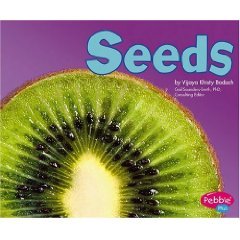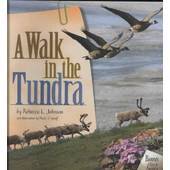Polar Plants: Virtual Bookshelf
The Virtual Bookshelf provides a list of recommended children’s books that reflect the theme of the issue and offers ideas on how to integrate them across the curriculum.
When students think about the Arctic tundra, most mention snow, ice, and polar bears. There is usually no mention of the 1,700 plant species, including 400 kinds of flowering plants. Arctic tundra plants have adapted to harsh conditions. They are typically small and grow clumped together to resist the wind and gain protection from the cold. Many of the plants have hairy leaves that hold in heat.
We’ve divided this month’s bookshelf into three categories: Plants and Plant Life, Arctic and Antarctic Plants, and Penguins and Polar Bears.
PLANTS AND PLANT LIFE
 |
How Does It Grow? From Seed to Sunflower. Ian Smith. 2004. Nonfiction book. Recommended ages: Grades K-2.
Simple text and bright photographs introduce sunflowers and the extraordinary journey they take from seed to plant. Includes directions for growing sunflowers and notes for using the book effectively in the classroom or in the home. |
 |
Seeds. Vijaya Khisty Bodach. 2007. Nonfiction book. Recommended ages: Grades K-2.
Easy text with photographs presents seeds, how they grow, and their uses. This is an introductory book from the Pebble Plus series. |
 |
From Seed to Plant. Gail Gibbons. 1991. Nonfiction book. Recommended ages: Grades K-5.
A simple introduction to how plants reproduce, discussing pollination, seed dispersal, and growth from seed to plant. Teachers of the early grades might use the illustrations to discuss a plant’s life cycle. The more detailed text is appropriate for use with older students. |
 |
A Parade of Plants. Melissa Stewart. 2004. Nonfiction book. Recommended ages: Grades: 2-4.
This book will help students study plants as a scientist does. It introduces the parts of a plant, life cycles, and plant growth. Includes interesting activities students can do to help them explore the world of plants. |
ARCTIC PLANTS
While the following books are about the tundra in general, they all contain information about the many species of plants found in the Arctic. Many of the books also discuss adaptations that enable the plants to survive in this harsh environment.
These books could also be used in a study of the diversity of plants around the world.
 |
Counting in the Tundra. Fredrick L. McKissack. 2008. Nonfiction book. Recommended ages: Grades K-2.
Most of the pages feature animals, but one of the two-page spreads is devoted to the pasque flower. Children can count the six petals of the flower and learn that it grows along the sides of mountains. |
 |
A Home on the Tundra. Katie Marsico. 2007. Nonfiction book. Recommended ages: Grades K-2.
This early reader has photographs and good information on lichens and shrubs. |
 |
Explore the Tundra. Linda Tagliaferro. 2007. Nonfiction book. Recommended ages: Grades 2-4.
Students will learn that many tundra plants grow in groups and that plants on the edge of the group protect the middle plants from the strong winds. Photographs of Arctic landscapes and wildlife make this an inviting and fascinating resource for young readers. |
 |
Discovering the Arctic Tundra. Janey Levy. 2008. Nonfiction book. Recommended ages: Grades 3-4.
Probably many people think that snow is harmful to Arctic plants, but snow is warmer than the air above it and serves as a blanket to protect the plants from harsh winds. Learn this and other amazing facts! |
 |
Tundra: The Barren Wilderness. Michael George. 2002. Nonfiction book. Recommended ages: Grades 3-5.
Students will learn that the tundra is full of life during the summer. Wildflowers, such as larkspur, louseworts, and dwarf clover, and bearberry shrubs rise from the shallow soil and paint the land with many colors. Readers will also learn that lichens are not really plants but organisms formed by algae and fungi growing together. Photographs and interesting text make this book a must for learning about the tundra. |
 |
A Walk in the Tundra. Rebecca L. Johnson. 2001. Nonfiction book. Recommended ages: Grades: 4-5.
Students will learn that Arctic plants have small, tough, leathery leaves because these leaves are able to stand up to cold and wind better than large leaves can. This book includes photographs and journal sketches of the Arctic landscape. |
PENGUINS AND POLAR BEARS
 |
Positively Penguins! Kathryn Stevens. 2009. Nonfiction book. Recommended ages: Grades 3-5.
This penguin resource is divided into three chapters: All about Penguins, Penguin Families, and Protecting Penguins. Students will learn about the different species, habitats, predators, food sources, and what people can do to protect penguins. The book has an index, a glossary, a list of recommended reading, and a website that students can access for further study on penguins. |
 |
Polar Bears: Arctic Hunters. Norman Pearl. 2009. Nonfiction book. Recommended ages: Grades 2-4.
Polar bears spend lots of time hunting. Seals are their favorite prey. Polar bears often wait by a breathing hole or at the edge of the ice. When a seal comes up for air, the polar bear bites into it and pulls it up on the ice. Learn these and other amazing facts about polar bears and their incredible hunting skills. |
This article was written by Julie Moran. For more information, see the Contributors page. Email Kimberly Lightle, Principal Investigator, with any questions about the content of this site.
Copyright March 2009 – The Ohio State University. This material is based upon work supported by the National Science Foundation under Grant No. 0733024. Any opinions, findings, and conclusions or recommendations expressed in this material are those of the author(s) and do not necessarily reflect the views of the National Science Foundation. This work is licensed under an Attribution-ShareAlike 3.0 Unported Creative Commons license.













